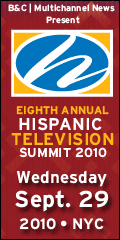Posted by Elena del Valle on August 25, 2010
By Adrienne E. Katz Katz

Adrienne E. Katz Katz
Mankind has walked on Earth for thousands of years, but women have been allowed to vote for only ninety years! It took 131 years after the U.S. Constitution was adopted before American men grudgingly granted women the right to vote.
Every woman today who has in her own name a job, a bank account, a credit card, a lease, a car, a mortgage, a diploma or a pension has these because she is standing on the shoulders of millions of women who fought for those privileges.
The United States is celebrating Women’s Equality Day on August 26, commemorating the passage of the 19th Amendment to the U.S. Constitution. This amendment gave women the right to vote on this date in 1920.
Click here to read the entire article Look how far we’ve come and how far we still have to go
Posted by Elena del Valle on August 24, 2010
Information provided by our Event Partner

The 8th Annual Hispanic Television Summit
Wednesday, September 29, 2010, Hilton New York Hotel
Special Offer for HispanicMPR.com subscribers
$50 off regular price of $399 until September 1st ($349) &
$100 off regular price of $499 after September 1st ($399)
The 8th Annual Hispanic Television Summit will be held Wednesday, September 29, 2010 at the Hilton New York Hotel. It is presented by Broadcasting & Cable and Multichannel News. Oscar De La Hoya will be honored for A Lifetime of Achievement in Hispanic Television. Confirmed keynote speakers are Ramón Escobar, EVP Telemundo; Diane Jones Lowrey, Director Diversity Marketing & Operations, Levi Strauss & Company; Alita Vegas, Director Multicultural Marketing, P&G. The Summit is the signature conference for executives involved in the business of television and digital video targeted to the US Hispanic and Latin American viewing audience and attended by over 400 key industry executives.
To register, please visit www.broadcastingcable.com/hispanic2010, www.multichannel.com/hispanic2010 or call Sandy Friedman at 646-746-6740.
Posted by Elena del Valle on August 23, 2010

Romano Richetta, senior vice president, Participant Services, TIAA-CREF
Photo: TIAA-CREF
A podcast interview with Romano Richetta, senior vice president, Participant Services, Teachers Insurance and Annuity Association College Retirement Equities Fund (TIAA-CREF) is available in the Podcast Section of Hispanic Marketing & Public Relations, HispanicMPR.com. During the podcast, Romano discusses his company’s Spanish language initiatives to provide United States Latinos access to a secure retirement with Elena del Valle, host of the HispanicMPR.com podcast.
Romano has served as senior vice president of Participant Services at TIAA-CREF since July 2006. He oversees TIAA-CREF’s Call Center and Field Consulting Group with more than 1,400 employees. From November 2001 to May 2006, Romano served as senior vice president at JPMorgan Chase & Co. where he managed the Telephone Channel in the retail bank.
Prior to joining that company he was a senior manager at Deloitte & Touche LLP serving as an operations and strategy consultant. Romano, who holds a Masters degree from Massachusetts Institute of Technology and an MBA from the University of Texas at Austin, is a registered principal and registered representative.
To listen to the interview, scroll down until you see “Podcast” on the right hand side, then select “HMPR Romano Richetta” click on the play button below or download the MP3 file to your iPod or MP3 player to listen on the go, in your car or at home. To download it, click on the arrow of the recording you wish to copy and save it to disk. The podcast will remain listed in the August 2010 section of the podcast archive.
Posted by Elena del Valle on August 20, 2010

The Secret Side of Anger
Placing blame on others for our actions and feelings is a common misconception of where the blame should really be, according to Janet Pfeiffer, author, The Secret Side of Anger (Tate Publishing and Enterprises, LLC, $12.99). She believes that taking responsibility for our own feelings and how we deal with them is empowering and the best approach and that finding inner peace is the ultimate goal.
“Most of us believe that other people or situations have the ability to make us angry. This is a big misconception,” said Pfeiffer. In her book she shares the wisdom about anger she has acquired over the years through personal situations and professional experiences coaching others.
Mixed in with jokes, personal and professional anecdotes and occasional references to God, Pfeiffer presents readers with tips on reducing anger that she says have made her personal and professional life better. In the 190-page book Pfeiffer explains that: thoughts lead to feelings and feelings are our choice; it is up to each person to choose the thoughts and feelings he or she has and how to deal with them; and it is up to each individual to take responsibility for his or her life.
“No individual or event has the power to make you mad. Anger is actually a choice, one that occurs depending on that person’s perception (thought). What we choose to think about an experience we’re having or the person we’re involved with determines how we feel. For instance, if someone criticizes you, you can think ‘She’s so mean!’ Or, you can choose, ‘How unfortunate someone could be so insensitive.’ The former evokes anger, the latter, sadness. The truth behind her actions matters little. You only need to concern yourself with how you choose to perceive her and allow her behavior to affect you.”
Pfeiffer, described in promotional materials as a certified violence counselor and motivational speaker, believes unresolved anger leads to resentment and bitterness and can damage a person’s relationships, health, career, and happiness. She is convinced that feeling anger is not in and of itself bad. What’s important is how people handle the feeling and what they do about it, she says in the book.
She believes that only if mishandled in a destructive or violent way does anger turn negative. She asserts that anger is an important and useful emotion that people can take advantage of to change their lives. An example of positive results that may follow anger is when someone witnesses an injustice in society which fuels his or her anger and eventually leads to the creation of new laws.
Anger, by definition, she says, is a feeling of distress born of feelings of helplessness or powerlessness. When people feel victimized it is because they feel others are controlling them but in reality power and control come from within. Regaining our personal power eliminates feelings of helplessness and anger. Others no longer have the ability to push our buttons and make us mad, she says.
Her tips on reducing anger include: Put everything into perspective. Ask yourself if the situation is worth getting upset about. If not, let it go. If it is important, identify what needs to change and create a plan to accomplish that. Switch your focus (thought) from the problem (negative) to the solution (positive). The moment you feel anger well up inside you, remember SWaT: Stop, Walk and Talk. Stop what you are doing. This prevents the situation from escalating. Next, Walk away. Creating distance allows you to calm down and cool off. “Out of sight, out of mind.”
Third: Talk yourself calm. Discuss your feelings and situation with a neutral party, seeking deeper understanding and guidance. If no one is available, talk to yourself. Repeat calming statements such as “I am fine. I am calm. I can handle this is an intelligent and rational manner.” Create a “Peace Plan”: daily activities to engage in that will naturally reduce your levels of anger. Each of these naturally replaces stress and anger with feelings of peace and serenity. Even a simple act such as deep breathing or smiling will help alleviate anger, she believes.
Pfeiffer, president and chief executive officer, Pfeiffer Power Seminars, LLC, is a motivational speaker, an instructor at a battered women’s shelter, personal coach, columnist, and founder of The Antidote to Anger support group.

Click here to buy The Secret Side of Anger
Comments:
Filed Under: Books
Posted by Elena del Valle on August 19, 2010
We recently found out by a comment from an audience member and then an email reply to Harald Vogt’s email address of his passing. The email said, “Caroline Pieper-Vogt and the family of Harald Vogt regret to inform you of Harald’s recent passing. All Scent Marketing Institute projects, newsletters and events are on hold until further information is available. The Vogt family thanks all for their help and support.” Although a phone call was unanswered we confirmed the news online at Tributes.com, http://www.tributes.com/show/Harald-Vogt-89044965
Earlier this year Harald contributed two Guest Articles to HispanicMPR. In addition HispanicMPR is a Media Partner to The Scent Marketing Institute’s Scent World 2010 event November 17-19, 2010 on Miami Beach, Florida. We extend our condolences to his family and friends.
Posted by Elena del Valle on August 18, 2010

Spanish language signage at a cell phone store
Photos: AT&T, Sony
A bird’s eye view of Latinos across the country reveals lower use of technology than that of non Latinos. Also, age and language preference are indicators of technology use. Older Latinos rely on technology less than young ones. Spanish dominant Latinos use of technology is lower than that of English dominant and bilingual Latinos.
More than two thirds (78 percent) of non Latino adults (18 and older) go online compared to 64 percent of Latinos of the same age; and 86 percent of non Latinos use cell phones while 76 percent of Latinos use cell phones.
At the same time, when it comes to the use of technology not all Latinos are equal. United States born Latinos use of the internet and cell phones is higher than that of foreign born Latinos. Latinos born in the United States are much more likely to use technology, especially the internet, than foreign born Latinos, according to a Pew Hispanic Center report released recently. The report, written by Gretchen Livingston, senior researcher, Pew Hispanic Center points to a significant difference between the two groups. The Pew Hispanic Center is a research organization that seeks to improve understanding of the U.S. Hispanic population.
For example, 85 percent of Latinos 16 and older born in the United States rely on the internet while only 51 percent of their foreign born counterparts surf the digital world. When it comes to cell phone use the difference is less marked: 80 percent of United States born Latinos use a cell phone while 72 percent of foreign born Latinos do so.

Sony Vaio J computer
If we look at technology use among young people in the United States the difference is also clear. Nearly all (96 percent) non Hispanic youth between 18 to 25 years of age surf the internet while only 77 percent of Hispanics go online. Eighty-two percent of non-Hispanics ages 16 and 17 use a cell phone while 72 percent of Hispanics of that age do so. Ninety-four percent of non Hispanics aged between 18 and 25 use a cell phone compared with eighty percent of Hispanics.
If we look at technology use among people 55 and older, there is still a difference between Latinos and non Latinos. Among non Latinos 75 percent use cell phones and 57 percent use the internet while only 60 percent of Latinos in that age group use cell phones and 42 percent use the internet.
When it comes to going online language preference is a key factor. A majority of English dominant (87 percent) Hispanics 16 and older and bilingual (77 percent) Hispanics are more likely to use cell phones than Spanish dominant Latinos (35 percent).
This report was based primarily on the 2009 National Survey of Latinos, conducted from August 5 through September 16, 2009 among a randomly selected, nationally representative sample of 2,012 Hispanics ages 16 and older. The survey was conducted in English and Spanish on landline and cellular phones.
Posted by Elena del Valle on August 17, 2010
WiredLatinos Directory, owned by Mygritomedia LLC, a new online directory offering paid and free listings, added HispanicMPR.com to its directory. WiredLatinosDirectory.com was launched by WiredLatinos.com.
According to the website, the directory is edited by humans. Company executives hope to compile “the most comprehensive list of Latino owned, managed, targeted and community serving websites.” See the HispanicMPR.com listing at http://www.wiredlatinosdirectory.com/hispanicmpr-com/
Posted by Elena del Valle on August 16, 2010

Reading, math scores by race/ethnicity – click to enlarge
Chart, photo: Center on Education Policy, CommunicationWorks
A colleague pondered out loud the other day: “In future decades how will marketers target America’s increasingly large emerging markets?” Although Asian American students are doing better than their emerging market counterparts, reading (and math) proficiency is low among Latinos and blacks compared to other students. If the young adults of the future can’t read will general marketing emphasize the visual and audio formats that they are able to consume?
In spite of some modest gains in test scores among Latinos in recent years, education gaps appear to be a serious problem that is not going away anytime soon. According to a recent report on Latino performance in school, in California, the state with the largest Latino enrollment, Latino students were the lowest-performing subgroup in reading at all grade levels.
On the last day of June 2010 the Center on Education Policy (CEP) released a series of reports on the performance of Latino, African American, Asian American, Native American and white students on state reading and math tests. The reports also examine the implications of CEP’s findings about achievement for each ethnic/racial subgroup.
Although Latinos still perform well below Asian American and white students on state tests and many issues remain to be resolved when it comes to education, especially in states with a high percentage of Latinos, according to the results of the reports, some Latino students are performing better on state reading and math tests than in the past.
Between 2002 and 2008 for grades four, eight and the high school grade assessed for the No Child Left Behind (NCLB) Act the performance of Latino students on state reading and math tests improved in most states.
At the same time according to the report as a group, African American students were often the lowest-performing racial/ethnic subgroup in 2008 on state reading and math tests at grades four, eight, and the high school tested in the majority of the states with sufficient data, as well as in the nine states with the highest numbers of African American test-takers. In contrast, as a group, Asian American students often outperformed other racial/ethnic subgroups in reading and math at grades four, eight, and the high school grade tested. In high school reading, however, white students did better than Asian American students in most states with sufficient data and sufficiently large Asian subgroups.
Despite gains, the Latino subgroup still remains among the lower-performing racial/ethnic subgroups on state tests. Across all states with adequate data, median percentages proficient for Latino students in reading and math in 2008 were well below those of the Asian and white subgroups. For example, in grade eight math the medians were 55 percent for Latino students, compared with 86 percent for Asian students and 77 percent for white students. Latino students were somewhat above or similar to medians of African Americans at 46 percent and Native Americans at 54 percent.

Jack Jennings, president and CEO, CEP
In 2008, Latino students were the lowest-performing racial/ethnic subgroup in at least one subject/grade combination in 11 states with sufficient data for the study. The achievement for Latino students in 2008 was slightly more negative in the five states that together enroll more than 70 percent of the nation’s Latino students California, Texas, Florida, New York and Arizona.
“These increases in test scores for Latino students are encouraging, but the achievement level of Latino students is nowhere near where it has to be,” said Jack Jennings, president and chief executive officer, CEP. “Latino students are the largest ethnic minority group in many states and are the fastest-growing nationally, and therefore it is crucial to improve achievement for these students.”
CEP analyzed 2008 state test results and trends since 2002 in the Latino-white achievement gap and in the percentages of Latino students reaching various achievement levels. Their findings were drawn from test data, gathered by CEP, from all 50 states.
The Latino student report indicates that states with increases for Latino fourth graders since 2002 outnumbered states with decreases at the basic, proficient, and advanced achievement levels. Latino students have also improved achievement at grades four, eight, and the tested high school at a fast enough rate to narrow gaps in the percentage reaching proficient in reading and math in a large majority of the states with sufficient data. Since 2002 gaps narrowed more often than they widened, according to the mean test scores results.
The researchers concluded that the “relatively low performance of Latino students, who in less than a generation will comprise roughly three in ten American children, is an urgent issue. The nation’s economic and social well-being will be compromised without efforts at all levels of government to develop policies to increase achievement for Latino young people.”
Based in Washington, D.C., and founded in January 1995 by Jack Jennings, the Center on Education Policy is “a national, independent advocate for public education and for more effective public schools.” According to a press release the Center represents no special interests. The Center strives “to help citizens make sense of the conflicting opinions and perceptions about public education and create conditions that will lead to better public schools.”
Posted by Elena del Valle on August 13, 2010

Hispanic New York A Sourcebook
In June, Columbia University Press published Hispanic New York A Sourcebook (Columbia University Press, $29.95), a book edited by Claudio Iván Remeseira, founder and director of the Hispanic New York Project which is hosted by Columbia University’s American Studies Program, about the Hispanic history of the city and its Latino communities. It may also be published in Spanish by a Latin American publishing company.
The book was designed as an anthology of scholarly, literary, autobiographical, and journalistic writings for high school and college students and based on a seminar taught by the editor and Roosevelt Montás, a colleague at Columbia University. It was meant to be a companion book to Hispanic New York: A Cultural Guide, a title that is still under production.
In addition to Remeseira the 547-page softcover book is the work of fourteen men and nine women: Jack Agueros, Theodore S. Beardsley Jr., Paul Berman, Dionisio Cañas, Ruby Danta, Margarite Fernández Olmos, Frank M. Figueroa, Gabriel Haslip-Viera, Carmen Dolores Hernández, Orlando José Hernández, José Marti, Ed Morales, Antonio Muñoz Molina, Frances Negrón-Muntaner, Lizabeth Paravisini-Gebert, Luis Pérez-Oramas, Milagros Ricourt, Clara Rodriguez, Virginia Sánchez Korrol, Roberto Suro, Bernardo Vega, Walt Whitman, and Ana Cecilia Zentella.

Claudio Iván Remeseira, editor, Hispanic New York A Sourcebook
“Since the moment I had the idea of producing this book to the moment it reached the bookstores, it was almost three years. But I started collecting the material that eventually made up the book around 2001. So you can safely say that the book took almost a decade in the making, and the last three years of that period to come into fruition,” said Remeseira by email when asked how many years the project required.
The book is divided into two main sections, People and Communities and Cultural Hybridizations, and 23 chapters: Introduction, The Evolution of the Latino Community in New York, A Vindication of Cuba, Memoirs of Bernardo Vega, Halfway to Dick and Jane, New York Teetering on the Heights, The Hispanic Impact Upon the United States, In Search of Latinas in U.S. History, 1540-1970s, The Spanish Element in Our Nationality, Racial Themes in the Literature, The Emergence of Latino Panethnicity, Creole Religions of the Caribbean, New York City Center and Transit Point for Hispanic Cultural Nomadism, Puerto Rican Voices in English, Spanish in New York, Spanish in New York a Moving Landscape, New York’s Latin Music Landmarks, The Story of Nuyorican Salsa, Mariachi Reverie, The Art of Babel in the Americas, The Life and Passion of Jean-Michel Basquiat, A Splendid Outsider, and Carlos Gardel in New York.

Click here to buy Hispanic New York: A Sourcebook
Comments:
Filed Under: Books





















